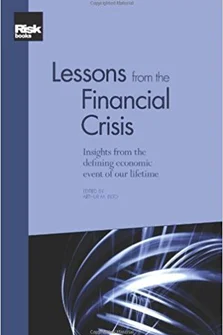Limits of Implied Credit Correlation Metrics Before and During the Crisis
Damiano Brigo, Andrea Pallavicini and Roberto Torresetti
Introduction to 'Lessons from the Financial Crisis'
The Credit Crunch of 2007: What Went Wrong? Why? What Lessons Can be Learned?
Underwriting versus Economy: A New Approach to Decomposing Mortgage Losses
The Shadow Banking System and Hyman Minsky’s Economic Journey
The Collapse of the Icelandic Banking System
The Quant Crunch Experience and the Future of Quantitative Investing
No Margin for Error: The Impact of the Credit Crisis on Derivatives Markets
The Re-Emergence of Distressed Exchanges in Corporate Restructurings
Modelling Systemic and Sovereign Risks
Measuring and Managing Risk in Innovative Financial Instruments
Forecasting Extreme Risk of Equity Portfolios with Fundamental Factors
Limits of Implied Credit Correlation Metrics Before and During the Crisis
Another view on the pricing of MBSs, CMOs and CDOs of ABS
Pricing of Credit Derivatives with and without Counterparty and Collateral Adjustments
A Practical Guide to Monte Carlo CVA
The Endogenous Dynamics of Markets: Price Impact, Feedback Loops and Instabilities
Market Panics: Correlation Dynamics, Dispersion and Tails
Financial Complexity and Systemic Stability in Trading Markets
The Martingale Theory of Bubbles: Implications for the Valuation of Derivatives and Detecting Bubbles
Managing through a Crisis: Practical Insights and Lessons Learned for Quantitatively Managed Equity Portfolios
Active Risk Management: A Credit Investor’s Perspective
Investment Strategy Returns: Volatility, Asymmetry, Fat Tails and the Nature of Alpha
In this chapter we analyse the limits of popular models or pseudo-models (mostly quoting mechanisms) that in the past have been extensively used to mark-to-market and risk manage multi-name credit derivatives. This chapter presents a compendium of results we first published before the crisis, back in 2006, pointing out the dangers in the modelling paradigms used at the time in the market, and showing how the situation has even worsened subsequently by analysing more recent data. The analysis also points out that the current paradigm had been heavily criticised before the crisis, referring to works by us and other authors addressing the main limitations of the current market paradigm well before popular accounts such as Salmon (2009), Jones (2009) and Lohr (2009) appeared.
We will present a comparison of how a selected set of credit derivatives models fared before and during the crisis, pointing to the fact that the problems plaguing both compound and base implied correlation worsened with the advent of the credit crunch.
To develop the above comparison, we first introduce the Gaussian copula, which represents a common way to introduce dependence in credit derivatives modelling
Copyright Infopro Digital Limited. All rights reserved.
As outlined in our terms and conditions, https://www.infopro-digital.com/terms-and-conditions/subscriptions/ (point 2.4), printing is limited to a single copy.
If you would like to purchase additional rights please email info@risk.net
Copyright Infopro Digital Limited. All rights reserved.
You may share this content using our article tools. As outlined in our terms and conditions, https://www.infopro-digital.com/terms-and-conditions/subscriptions/ (clause 2.4), an Authorised User may only make one copy of the materials for their own personal use. You must also comply with the restrictions in clause 2.5.
If you would like to purchase additional rights please email info@risk.net










